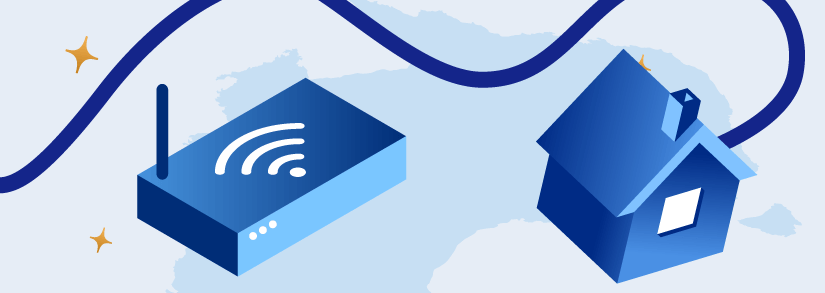NBN Hybrid Fibre Coaxial (HFC) Explained | Australia 2025
The NBN is a mix of different infrastructures, technologies, and connections, which all come together to create the National Broadband Network. Hybrid fibre-coaxial, or HFC, is one part of this network, using preexisting pay TV cables to deliver broadband to around 27% of homes and businesses within the NBN. If you have an HFC connection, or want to learn more about how HFC compares to other NBN technologies such as FTTN or FTTP, continue reading below.
What is HFC?
Hybrid fibre-coaxial, or HFC, is a type of NBN connection, which utilizes existing “pay TV” cables (rather than copper telephone wires used in many other NBN connections) to make the final part of the NBN connection to your home. HFC is a critical component of the NBN, and currently covers around 27% of Australian NBN consumers.
It’s important to note that hybrid fibre-coaxial is not the same as cable broadband, despite the fact that both these types of broadband use the same cable infrastructure.
How Does HFC Work?
The NBN is a multi-technology mix (or MTM), utilizing different types of connections to bring high-speed broadband to Australians. Hybrid fibre-coaxial is one type of connection.
HFC uses the network of pay TV cables, built in the 1990’s by Telstra and Optus for services such as Foxtel, to now deliver broadband to Australians. Similar to other NBN connections, such as FTTN and FTTB, fibre-optic cables are used to deliver broadband to a central node. Unlike FTTB or FTTN which use copper telephone wires to complete the NBN connection from the node to your home, HFC uses the pay TV cables to complete the connection from the node.
In order for your home to connect to the NBN through a hybrid fibre-coaxial connection, you will need the existing cable connection in your home. It should be noted that even if you have an existing cable connection, it does not mean your NBN will be HFC, that is up to the NBN rollout and the type of NBN available in your area.
With an HFC connection, you will need the same equipment as other types of NBN, namely the NBN utility box outside of the premises and an NBN connection box inside your home, both supplied by the NBNCo, as well as a router or WIFI modem usually supplied by your ISP. With HFC you can still get a home phone line, called VoIP, like you would with any other NBN connection. In addition, if you already use the coaxial connection for a pay TV service or non-NBN cable broadband, the NBNCO can provide a cable splitter.

Looking for a New Internet Plan for Your Home?
Selectra Can Provide Advice & Help You Find The Best Plan

Looking for a New Internet Plan for Your Home?
Selectra Can Provide Advice & Help You Find The Best Plan
How Fast is HFC? Hybrid Fibre-Coaxial Download Speeds
HFC download speeds are comparable to other types of NBN connection, such as FTTN and FTTP, though significantly faster than ADSL. All HFC connections should be able to reach NBN100 speeds, meaning a maximum speed of 100Mbps download and 40Mbps upload and, according to the ACCC Broadband Speed Test, HFC delivered about 86% of the maximum plan speed during the busiest hours.
| NBN Connection Type | Percentage of Maximum Speed for All Services |
|---|---|
| Fibre-to-the-premise (FTTP) | 101% |
| Fibre-to-the-Node (FTTN) | 90% |
| Fibre-to-the-Curb (FTTC) | 99% |
| Hybrid fibre-coaxial (HFC) | 100% |
It should be noted that if you’re looking for one of the new, high-speed NBN plans, NBN250 (Superfast) and NBN1000 (Ultrafast), not all HFC connections can reach those speeds. Currently, around 70% of all HFC connections can reach 250Mbps, but NBNCO has plans to extend this speed to all HFC connections by June 2021. For those who want NBN Ultrafast, HFC is configured to reach 750Mbps with potential bursts of 990Mbps, and is only available to 7% of current HFC connections.

Looking for a New Internet Plan for Your Home?
Selectra Can Provide Advice & Help You Find The Best Plan

Looking for a New Internet Plan for Your Home?
Selectra Can Provide Advice & Help You Find The Best Plan
HFC vs FTTN
HFC is a type of NBN connection, like Fibre-to-the-Node (FTTN), Fibre-to-the-Premise (FTTP), Fibre-to-the-Curb (FTTC), and Fibre-to-the-Basement (FTTB) and all these technologies work together to deliver the NBN to more than 90% of homes and businesses.
The biggest difference between HFC and all other types of fixed wire NBN connections, outside of the actual infrastructure used to complete the connection, is speed. While more and more connection types are reaching higher percentages of total maximum download speed (90% or more), FTTN still falls short of reaching its full potential when compared to HFC.
In addition, FTTN connections still aren’t usually able to support NBN250 or faster while a small number of HFC connections can support these Superfast and Ultrafast download speeds. However, NBN consumers who have a FTTN connection may be able to get an upgrade to FTTP which is able to support these 250+Mbps download speeds.
Can I Choose Which NBN Connection I Want?
Whether you want an HFC connection, or you have one and want a different type of NBN, the short answer is no, you cannot choose the type of NBN connection you get to your home. It all depends on the type of infrastructure available in your home and on your street, with only one type of connection available per premise.
If your neighborhood is not part of the FTTP expansion, it is also possible to request, and pay for, an upgrade yourself through the NBN Technology Choice tool with some neighborhoods or streets raising money together to get an upgrade. It is important to note that switching to FTTP is not cheap. Applications alone can cost upwards of $330 per premise, and the actual upgrade can get as high as $10,000 or more to upgrade an entire apartment building.
If you're not yet eligible for high-speed NBN or HFC, you can also choose to connect your home to the 5G network using home wireless broadband without the need for steep installation costs or for a technician to come out.
Frequently Asked Questions About NBN HFC
What is NBN Hybrid Fibre Coaxial (HFC)?
HFC is a type of NBN connection that uses existing pay TV cable infrastructure to deliver broadband to premises, combining fibre optics and coaxial cable.
How does HFC work?
Fibre runs to a central node, and from there, existing pay TV coaxial cables connect directly to your home, providing internet via NBN connection boxes and modems.
How fast is NBN HFC?
HFC reliably achieves speeds up to 100Mbps download and 40Mbps upload. Increasingly, 70% of HFC connections support speeds up to 250Mbps, and some upgraded connections reach 750Mbps or 1000Mbps.
How does HFC compare to other NBN technologies?
HFC generally provides better speed and reliability than Fibre-to-the-Node (FTTN), but Fibre-to-the-Premises (FTTP) offers the fastest and most stable connections.
Can I choose my NBN connection type, such as HFC?
No, connection type depends on your home and neighbourhood infrastructure. Some areas are eligible for upgrade programs, but generally you cannot choose the technology.
What equipment is needed for NBN HFC?
You will need an NBN utility box outside your home, an NBN connection box inside, and a compatible modem or router supplied or recommended by your provider.
Click below to find a better deal for your home!




